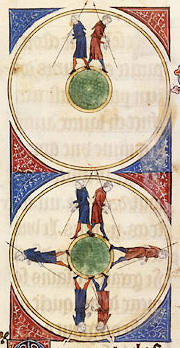List of common misconceptions facts for kids
This article is about things many people believe are true, but actually aren't! These ideas often come from old stories, misunderstandings, or even jokes that people started to take seriously. It's fun to learn the real facts behind these common mix-ups!
Contents
- Fun Facts About Arts and Culture
- History Highlights
- Science, Tech, and Math Facts
- Astronomy and Spaceflight Surprises
- Biology Breakthroughs
- Chemistry and Materials Science Clarifications
- Computing and Internet Insights
- Economics Explained
- Earth and Environmental Science Facts
- Geography Gems
- Human Body and Health Hints
- Inventions and Innovations Insights
- Mathematics Mysteries
- Physics Puzzles
- Psychology and Neuroscience Notes
- See also
Fun Facts About Arts and Culture
Business Buzz
- In the United States, businesses don't have to accept cash for every payment. While cash is valid for paying off debts, a store can choose to only accept cards, for example.
- The name Adidas is not short for "All day I dream about sports." It's actually named after its founder, Adolf Dassler, who was nicknamed "Adi."
- The letters "AR" in AR-15 stand for "ArmaLite Rifle." This is the company that first made the weapon. It does not mean "assault rifle" or "automatic rifle."
- The Chevrolet Nova car sold well in places like Latin America. The idea that it didn't sell because "no va" means "it doesn't go" in Spanish is a myth. People understood "nova" to mean "new."
- The jolly image of Santa Claus in red clothes wasn't created by The Coca-Cola Company. This look for Santa was already popular in America before Coca-Cola started using him in their ads in the 1930s.
- Netflix wasn't started because its co-founder, Reed Hastings, got a big late fee from Blockbuster. Hastings made up that story to explain why Netflix was a good idea. The founders were actually inspired by Amazon.
- PepsiCo never owned the "6th most powerful navy" in the world. In 1989, Pepsi got some old warships from the Soviet Union as part of a trade deal. They leased out the oil tankers and sold the other ships for scrap.
Food and Cooking Fun
- Searing meat, like when you cook a steak, does not seal in moisture. In fact, it makes the meat lose some moisture! Searing is done to make meat brown and improve its taste and texture.
- Twinkies, a popular American snack cake, only stay fresh for about 45 days. The joke that they last for decades isn't true.
- Most foods can be eaten safely after their "expiration" dates if stored correctly. Many "use by" dates are about food quality, not safety. They tell you when the manufacturer guarantees the best quality.
- The seeds of chili peppers are not the spiciest part. The highest concentration of capsaicin, which makes peppers hot, is in the white part (placental tissue) that the seeds are attached to.
- Turkey meat does not make you more sleepy than other foods. Drowsiness after big meals, like Thanksgiving dinner, usually comes from eating too much.
- Banana-flavored candy doesn't taste like a specific old type of banana. It tastes different because it uses only one of the many flavor compounds found in bananas. This compound is also in many other fruits.
Food History Facts

Fortune cookies are often found in Chinese restaurants, but they were actually invented in Japan.
- Fortune cookies are not from Chinese cuisine. They were invented in Japan and brought to the US by Japanese immigrants. In China, they are seen as an American thing and are very rare.
- Hydrox cookies were not a copy of Oreos. Hydrox was invented in 1908, four years before Oreos. Hydrox actually sold better until the 1950s.
- George Washington Carver did not invent peanut butter. Peanut butter was used by the Aztecs and Incans long ago. The first patent for peanut butter was filed in 1895. Carver did find many uses for peanuts and other plants.
- Potato chips were not invented by a chef named George Speck because a customer complained about thick fries. Recipes for potato chips existed before this story.
- Spices were not used in the Middle Ages to hide the taste of bad meat. Spices were very expensive. People who could afford spices could also afford good meat.
- Steak tartare was not invented by Mongol warriors tenderizing meat under their saddles. This dish started in Europe in the early 1900s.
- Whipped cream was not invented by François Vatel in 1671. The recipe was known much earlier in France and England.
Microwave Oven Myths
- Microwave ovens do not cook food by tuning into a specific frequency for water molecules. They cook food by heating up polar molecules, including water.
- Microwave ovens do not cook food from the inside out. Microwaves can only go about 1 centimeter (0.4 inches) into most foods. The inside of thicker foods gets hot from the heat moving from the outside.
- Microwave ovens do not cause cancer. Microwave radiation is not strong enough to cause the kind of cell damage that leads to cancer.
- Microwaving food does not reduce its nutritive value. It might even keep nutrients better than other cooking methods because it cooks food faster.
Film and TV Facts
- Ronald Reagan was never seriously considered for the main role in the 1942 film Casablanca. The studio already knew he was going into military service.
- George A. Romero's 1968 film Night of the Living Dead did not call the undead creatures "zombies." They were called "ghouls." The term "zombies" became popular later.
- Snow White and the Seven Dwarfs was not the first full-length animated film. An Argentine film from 1917, El Apóstol, was the first. Snow White was the first to use cel animation, which became very popular.
- The 1939 film The Wizard of Oz was not the first color film. Color film processes existed as early as 1909.
Language Lessons
- The Spanish "th" sound (like in "Barcelona") did not come from a king with a lisp. This pronunciation developed naturally over centuries.
- Sign languages are not the same all over the world. Most countries have their own unique sign language.
- The Chinese word for "crisis" (危机) is not made of symbols for "danger" and "opportunity." The second symbol means "turning point."
- The word "gringo" did not come from soldiers singing "Green Grow the Lilacs." It likely came from the Spanish word griego, meaning "Greek," used to mean "foreigner."
English Language Facts
- The word Irregardless is a real word. It might be informal or slang, but it appears in many dictionaries. All words become accepted by being used commonly over time.
- It is perfectly fine to end a sentence with a preposition. This "rule" came from trying to copy Latin, but it's a natural part of English.
- African American Vernacular English speakers don't just replace "is" with "be" randomly. They use "be" to show that something happens regularly or habitually.
- The expression "rule of thumb" did not come from a law allowing men to beat their wives. It comes from trades where people measured things with their thumb.
- The word the was never pronounced or spelled "ye" in Old or Middle English. The confusion comes from an old letter (þ) that looked like "y" in early printing.
- The word wop did not come from "without papers." It came from an Italian word guappo, meaning "thug" or "dandy.
- Xmas did not start as a way to "take the Christ out of Christmas." The "X" is the Greek letter "Chi," which is the first letter of "Christ" in Greek. It's an old abbreviation.
Music Myths
Classical Music Facts
- The musical interval called a tritone was never thought to summon the devil or banned by the Catholic Church. It was used in early medieval music.
- Mozart did not die from poisoning. The false rumor started after his colleague Antonio Salieri died.
- The minuet in G major is often thought to be by Johann Sebastian Bach, but it was actually written by Christian Petzold.
- Listening to Mozart or classical music does not make you smarter. A 1993 study showed a short-term improvement in spatial reasoning, but later studies found mixed results.
- The "Minute Waltz" by Chopin takes about two minutes to play. Its name comes from the word minute meaning "small," not the unit of time.
Popular Music Facts
- "Edelweiss" is not the national anthem of Austria. It was written for the 1959 musical The Sound of Music.
- The Monkees did not outsell the Beatles and the Rolling Stones combined in 1967. This claim was a joke made by Michael Nesmith in an interview.
- The Beatles' 1965 concert at Shea Stadium was not the first rock concert in a large outdoor stadium in the U.S. Elvis Presley played in such venues in the 1950s.
- Concept albums did not start with rock music in the 1960s. Singers like Frank Sinatra made them in the 1940s and 1950s.
Religion Facts
Buddhism Basics
- The historical Buddha was not fat. The chubby monk known as the "fat Buddha" in the West is a Chinese folk hero named Budai.
Christianity Clarifications
- Jesus was most likely not born on December 25. His birth was probably in spring or summer.
- The Bible does not say exactly three magi visited baby Jesus, or that they were kings. It only says there was more than one magus.
- Paul the Apostle did not change his name from Saul. He had both a Hebrew name (Saul) and a Greco-Roman name (Paul) from birth.
- Roman Catholic dogma does not say the pope is sinless or always infallible. It states that certain very specific teachings from the pope are free from error, but this is rare.
- St. Peter's Basilica is not the main church of Roman Catholicism. That honor belongs to the Archbasilica of Saint John Lateran in Rome.
- Saint Augustine did not say "God created hell for inquisitive people." He actually said he would not say that and that he didn't know the answer to such deep questions.
- The First Council of Nicaea did not decide which books would be in the Bible. The Old Testament was mostly set before Christ. The New Testament was mostly decided by the third century, before the Council in 325 AD.
Islam Insights

Afghan women wearing burqas.

Turkish women wearing niqābs.

Turkish women wearing hijabs.
- Most Muslim women do not wear a burqa, which covers the whole body and face. Many cover their hair and face (except eyes) with a niqāb, or just their hair with a hijab. Many Muslim women wear no head covering at all.
- A fatwa is a non-binding legal opinion from an Islamic scholar. It's not usually a death sentence. The idea that it is comes from a famous fatwa issued in 1989.
- The word "jihad" does not always mean "holy war." It literally means "struggle" in Arabic. It can refer to any spiritual or moral effort, like seeking knowledge or helping others.
Judaism Journeys
- The forbidden fruit in the Book of Genesis is never called an apple. The original texts just say "tree" and "fruit."
- Jews with tattoos are not forbidden from being buried in a Jewish cemetery.
Sports Stories
- The name golf is not an acronym for "Gentlemen Only, Ladies Forbidden." It likely comes from old Dutch or Scottish words for "club" or "to strike."
- Baseball was not invented by Abner Doubleday in Cooperstown, New York. It likely grew from other bat-and-ball games like cricket.
- A black belt in martial arts doesn't always mean you're an expert. It was first used to show basic skill in judo.
- The idea that only teams winning the FA Cup can use triangular corner flags in English football is a myth. The rules don't say anything about flag shape.
- India did not drop out of the 1950 FIFA World Cup because their players wanted to play barefoot. India withdrew due to lack of preparation and funding.
Video Game Vexations
- The "Nuclear Gandhi" glitch, where Gandhi became aggressive in the Civilization games, did not exist in the first two games. It was a joke that became popular online and was later added to Civilization V and VI as a reference.
- The Japanese government did not ban Square Enix from releasing Dragon Quest games on weekdays. There were concerns about kids skipping school, but no ban.
- The release of Space Invaders in 1978 did not cause a shortage of ¥100 coins in Japan. The shortage was due to low coin production and people hoarding silver coins.
History Highlights
Ancient Times Tidbits
- The Pyramids of Egypt were not built by slaves. Workers were paid with food and tax breaks. The idea of slaves building them came from an ancient historian.
- Ancient galleys were not usually rowed by chained slaves. They were rowed by paid workers or soldiers.
- Tutankhamun's tomb does not have a curse on it. This was made up by journalists in the 20th century.
- The Minoan civilization was not destroyed by the eruption of Thera. The eruption happened centuries before the Minoan era ended.
- Ancient Greek and Roman sculptures were originally painted in bright colors. They look white today because the paint has worn off.
- The Roman salute, with an outstretched arm, was not used in ancient Rome. It was first shown in a 1784 painting and later inspired the Nazi salute.
- Scipio Aemilianus did not sow salt over the city of Carthage after defeating it.
- Julius Caesar was not born by caesarean section. Such a surgery would have killed his mother at the time, and she lived until he was 45.
Middle Ages Mysteries
- The Middle Ages were not a time of total "Dark Ages" or ignorance. Many advances in learning and culture happened during this period.
- People in the Middle Ages did not usually die in their 30s or 40s. That was the average life expectancy at birth, which was low because many babies and children died. Adults who survived childhood often lived much longer.
- There is no proof that Viking warriors wore horns on their helmets. This would have been very impractical in battle.
- Vikings did not drink out of the skulls of their enemies. This idea came from a mistranslation of old poetry.
- Vikings did not name Iceland "Iceland" to stop others from settling there. Explorers saw snow and ice on the island, so they named it that. Greenland was named to attract settlers.
- In the story of King Canute and the tide, the king did not think he could stop the tide. He wanted to show his advisors that no human is all-powerful.
- Marco Polo did not bring pasta from China. Pasta first appeared in Italy way before Marco Polo began his travels to Asia.
- Spiral staircases in castles were not designed to hinder right-handed attackers. They were common in many buildings, not just military ones.
- Medieval European scholars knew the Earth was round. Scholars have known the Earth is spherical since at least 500 BCE.
- Medieval mapmakers did not regularly write "here be dragons" on their maps. Only a couple of maps from that time have this phrase.
- Christopher Columbus's voyages were not stopped by people believing the Earth was flat. The concern was that the East Indies were much farther away than he thought. Columbus actually underestimated the Earth's size.
- Christopher Columbus was not the first European to visit the Americas. Leif Erikson, a Viking, explored North America centuries before Columbus. Columbus also never reached mainland North America, only islands and parts of South America.
Early Modern Era Events
- The Mexica people (Aztecs) did not think Hernán Cortés and his men were gods. This idea came from a writer who never went to Mexico.
- Shah Jahan, who built the Taj Mahal, did not cut off the hands of the workers or designers. This is an urban myth.
- The early settlers of the Plymouth Colony did not usually wear all black clothes or tall hats with buckles. Their fashion was similar to what was popular in England at the time.
- The story that Isaac Newton was inspired by an apple falling on his head is probably not true. He said the idea came to him while he was thinking.
- Marie Antoinette did not say "let them eat cake" when she heard people were starving. This phrase was written before she was born and was not linked to her until much later.
- George Washington did not have wooden teeth. His dentures were made of lead, gold, ivory, and human teeth.
- The United States Declaration of Independence was not signed on July 4, 1776. It was approved on July 4th, but the actual signing happened on August 2, 1776.
- Benjamin Franklin did not suggest the wild turkey as the symbol for the United States instead of the bald eagle. He did express a personal preference for the turkey in a private letter.
- There was never a bill to make German the official language of the United States. A petition to publish some laws in German was put aside in 1794.
Modern History Moments

Napoleon on the Bellerophon by Charles Lock Eastlake. Napoleon was not unusually short.

Albert Einstein, photographed at 14. He did not fail math in school.
- Napoleon Bonaparte was not especially short. He was about average height for a Frenchman of his time.
- The nose of the Great Sphinx of Giza was not shot off by Napoleon's troops. It had been missing since at least the 10th century.
- Cinco de Mayo is not Mexico's Independence Day. It celebrates the Mexican Army's victory over the French in the Battle of Puebla on May 5, 1862.
- Albert Einstein did not fail mathematics in school. He said he had mastered advanced math before he was 15. He did fail an entrance exam once, but scored very well in math and science.
- Alfred Nobel did not leave out mathematics from the Nobel Prize because of a rivalry. He likely thought math was too theoretical to benefit humankind directly.
- The Italian dictator Benito Mussolini did not "make the trains run on time." Many repairs were done before he came to power, and the trains weren't always on schedule.
- There is no evidence that Polish cavalry charged German tanks with lances in 1939. This story may have come from German propaganda.
- The Nazis did not use the term "Nazi" to refer to themselves. It was a derogatory term used by their opponents.
- During World War II, King Christian X of Denmark did not wear a yellow star to protect Jews. Jews in Denmark were never forced to wear the Star of David.
- US President John F. Kennedy's words "Ich bin ein Berliner" mean "I am a Berliner (citizen of Berlin)." He was not saying "I am a jelly doughnut."
- The Moscow–Washington hotline was never a red telephone line. It started as a teletype link and is now a secure computer link for emails.
United States Uncovered

Areas covered by the Emancipation Proclamation are in red.
- Betsy Ross did not design or make the first official U.S. flag. This claim was made by her grandson a century later.
- The Emancipation Proclamation did not free all slaves in the United States. It only applied to states in rebellion. The Thirteenth Amendment later abolished slavery nationwide.
- Juneteenth celebrates the announcement that the Emancipation Proclamation would be enforced in Texas in 1865. It did not free all slaves in the U.S.
- Abraham Lincoln did not write his Gettysburg Address on the back of an envelope on a train. The speech was mostly finished before he left Washington.
- The Alaska Purchase was generally seen as a good thing in the U.S. The idea that it was "Seward's Folly" was a minority opinion.
- Cowboy hats were not initially popular in the American West. Bowler hats were more common. Cowboy hats became popular later due to marketing.
- The Great Chicago Fire of 1871 was not caused by Mrs. O'Leary's cow kicking over a lantern. A reporter later admitted he made up the story.
- The story of Frederic Remington and William Randolph Hearst about the Spanish–American War is probably not true.
- Immigrants' last names were not changed at Ellis Island. Officials there only checked ship records. People could change their names later if they wished.
- The 1930 painting American Gothic shows a father and his adult daughter, not a husband and wife.
- There was no widespread panic in the U.S. due to Orson Welles' 1938 radio show The War of the Worlds. Newspapers exaggerated isolated reports to discredit radio.
- American pilot Kenneth Arnold did not use the term flying saucer to describe a 1947 UFO sighting. He said the objects "flew like a saucer."
- Rosa Parks was not sitting in the "white" section of the bus. She was in the front of the "colored" section and refused to give up her seat to a white passenger.
- The activist W. E. B. Du Bois did not renounce his U.S. citizenship. His passport was not renewed, and he took Ghanaian citizenship, but he never officially gave up his American citizenship.
- The Pruitt–Igoe housing project never won awards for its design. The architectural firm won an award for a different project.
- There is little evidence that US Vietnam veterans were spat upon by anti-war protesters. This belief was popularized by films.
Science, Tech, and Math Facts
Astronomy and Spaceflight Surprises

The far side of the Moon, lit by the Sun.

A satellite image of a section of the Great Wall of China.
- There is no scientific evidence that the motion of stars and planets affects human fates. Astrology cannot predict future events.
- Astronauts in orbit are weightless because they are constantly falling around the Earth. The Earth's gravity is still very strong where the International Space Station is.
- The "dark side of the Moon" gets about the same amount of sunlight as the near side. It's called "dark" because we never saw it from Earth until spacecraft went there.
- Black holes have the same gravitational pull as any other object of the same mass. If our Sun became a black hole, the planets' orbits would not change.
- Seasons are not caused by the Earth being closer to the Sun in summer. They are caused by the Earth's 23.4-degree tilt. When a hemisphere tilts towards the Sun, it's summer there.
- When a meteor or spacecraft enters the atmosphere, the heat is mainly caused by the air in front of it being squeezed, not by friction.
- Egg balancing is possible any day of the year, not just on the vernal equinox.
- The Fisher Space Pen was not a multi-million dollar NASA project. It was developed by a private company, and NASA bought them for $6 each. The Soviet Union also bought them.
- Tang, Velcro, and Teflon were not created by NASA for spaceflight. Many other products, like memory foam, were.
- The Sun is not yellow. It emits all colors of light, which combine to look white outside Earth's atmosphere. Our atmosphere scatters blue light, making the Sun appear yellow.
- The Great Wall of China is not the only human-made object visible from space or from the Moon. Astronauts cannot see it from the Moon without magnification. City lights are easily visible from orbit at night.
- The Big Bang model does not explain how the universe began. It describes how the universe developed from a very hot, dense state.
Biology Breakthroughs
Vertebrate Veracity
- Old elephants do not leave their herd to go to an "elephants' graveyard" to die.
- Bulls are not angered by the color red. They are colorblind to red. They charge because of the movement of the bullfighter's cape.
- Dogs do not sweat by salivating. They sweat mainly through their footpads. They cool down mostly by panting.
- Dogs do not consistently age seven times faster than humans. Their aging varies by breed. Most dogs reach adolescence by one year old.
- The phases of the Moon do not affect how often wolves howl. Wolves howl to communicate with their pack, often before or after hunts.
- There is no such thing as an "alpha" in a wolf pack in the wild. Wolf packs are like families, with parents in charge.
- Bats are not blind. All bat species have eyes and can see. Many use echolocation to navigate in the dark.
- The memory span of goldfish is much longer than a few seconds, up to several months.
- Sharks can get cancer. The idea that they don't was spread to sell shark cartilage as a cancer treatment.
- Great white sharks do not mistake human divers for seals. They have good eyesight. Their bites on humans are usually for identification, not hunting.
- Snake jaws cannot unhinge. Their jaw bones are connected by flexible ligaments, allowing them to open their mouths very wide.
- Tomato juice and tomato sauce do not neutralize skunk odor. They only temporarily mask it. A mixture of hydrogen peroxide, baking soda, and dish soap works better.
- Porcupines do not shoot their quills. They can detach, and porcupines will back into attackers to impale them.
- Mice do not have a special love for cheese. They prefer sweet foods. The myth may come from cheese being an easily accessible food in the past.
- Piranhas are omnivores, eating both meat and plants. They swim in schools for defense, not to attack. They rarely attack humans.
- The hippopotamus does not produce pink milk or sweat blood. Their skin secretions are red due to a natural sunscreen, which is not blood or sweat. Their milk is white or beige.
- Only a few frog species, like the Pacific tree frog, make a "ribbit" sound. This misconception comes from Hollywood films.
- Touching or handling eggs or baby birds will not make adult birds abandon them.
- Eating rice, yeast, or Alka-Seltzer does not cause birds to explode. Birds can pass gas and some even eat wild rice.
- The loud cry often linked to the bald eagle is actually from a red-tailed hawk. Bald eagles have softer, chirpier calls.
- Ostriches do not stick their heads in the sand to hide or sleep. This myth may have come from an ancient writer.
- A duck's quack actually does echo.
- There's no proof that Eugene Schieffelin released 60 starlings in New York's Central Park to introduce every bird mentioned in William Shakespeare's works.
- The skin of a chameleon is not just for camouflage. They can't change to match any background.
- Rabbits are not especially fond of carrots. Carrots are high in sugar and unhealthy for them in large amounts. This myth came from Bugs Bunny cartoons.
Invertebrate Insights
- Not all earthworms become two worms when cut in half. Only some species can regrow their front half.
- Houseflies live for 20 to 30 days, not 24 hours.
- The daddy longlegs spider is not the most venomous spider. Its bite causes only a mild burning sensation.
- People do not swallow many spiders during sleep. Spiders usually avoid sleeping humans.
- It is not true that aerodynamic theory predicts that bumblebees should not be able to fly. The physics of insect flight is well understood.
- Earwigs are not known to purposely climb into human ears. Their name might refer to the shape of their hindwings.
- European honey bees are not essential for all human food production. Many important crops don't need insect pollination.
- Ticks do not jump or fall from trees. They wait on plants to grasp onto passing hosts.
- Termites are not ants. They are actually a type of cockroach.
- Cockroaches would not be the only organisms to survive nuclear fallout. While they are radiation-resistant, other insects are even more so.
Plant Ponderings

Sunflowers do not always point to the Sun.
- Carnivorous plants can survive without food. Catching insects helps them grow better.
- Poinsettias are not highly toxic to humans or cats. They might cause mild stomach upset if eaten, but rarely serious problems.
- Sunflowers do not always point to the Sun. Mature sunflowers face a fixed direction, often east. Young sunflower buds do track the Sun.
- Mushrooms, molds, and other fungi are not plants. They are more closely related to animals.
Evolution and Paleontology Puzzles

Pelagornis. Birds are dinosaurs.

Dimetrodon was not a dinosaur.
- The word theory in "the theory of evolution" does not mean it's just a guess. A scientific theory is a well-supported explanation for observable phenomena.
- The theory of evolution does not explain the origin of life or the universe. It explains how life changes over generations.
- Evolution is not a straight line from "inferior" to "superior" organisms. It means organisms become better suited to their environment.
- The phrase "survival of the fittest" refers to how well an organism can reproduce, not how strong it is.
- Evolution does not "plan" to improve an organism. Changes happen through natural selection based on what helps an organism survive and reproduce.
- Mutations are not entirely random. Some parts of an organism's genes are more likely to mutate than others.
- The word dinosaur is often used to mean only non-bird dinosaurs. However, birds are theropod dinosaurs, so dinosaurs are not extinct.
- Mosasaurs, ichthyosaurs, and plesiosaurs were not dinosaurs. They were other types of ancient reptiles.
- Dimetrodon was not a dinosaur and lived millions of years before dinosaurs appeared. It is more closely related to mammals.
- Pterosaurs (like pterodactyls) were not "flying dinosaurs." They were closely related to dinosaurs but are a separate group.
- Humans and non-bird dinosaurs did not live at the same time. The last non-bird dinosaurs died out about 63 million years before the first humans evolved. Humans did live with woolly mammoths and saber-toothed cats.
- Fossil fuels do not come from dinosaur fossils. Oil comes from tiny marine organisms, and coal comes from ancient plants.
- Mammals did not evolve from modern reptiles. Mammals and reptiles evolved from a common "reptile-like" ancestor.
- Humans and other apes are Old World monkeys. The word monkey is often used to mean only those with tails, but this is not scientifically accurate.
- Humans did not evolve from living species of chimpanzees. Humans and chimpanzees evolved from a common ancestor millions of years ago.
- Humans are animals. The word animal is often used to mean "not human," but humans are part of the animal kingdom.
Chemistry and Materials Science Clarifications
- Glass does not flow at room temperature. It is a solid. Old glass that is thicker at the bottom was made that way during production.
- Most diamonds are not formed from highly compressed coal. They form deep underground from carbon, long before most coal existed.
- Diamonds are not infinitely hard. They can be scratched by other diamonds and worn down by softer materials.
- Neither "tin" foil nor "tin" cans are primarily made of tin anymore. They are mostly aluminum or steel.
- Wooden pencils do not contain the element lead. The core is made of graphite.
Computing and Internet Insights
- The macOS and Linux operating systems are not immune to malware or computer viruses. Malware exists for these systems, though most is for Microsoft Windows.
- Private browsing (like Chrome's "Incognito Mode") does not protect you from being tracked by websites, employers, or your internet service provider (ISP).
- Submerging a phone in rice after water damage has not been proven to work. Other materials like silica gel are better at drying.
Economics Explained
- The number of people living in extreme absolute poverty worldwide has decreased over the last few decades.
- Human population growth is slowing down. The world population is expected to peak and then start falling this century.
- The idea that there's a fixed amount of work (a "lump of labor") is false. Automation doesn't always cause permanent job loss.
- Your income is not a direct factor in your credit score in the United States. Your credit score is affected by how much credit you use compared to what's available.
- The US public greatly overestimates how much money is spent on foreign aid.
- In the US, earning more money will not reduce your total take-home pay by putting you in a higher tax bracket. Only the money earned in the higher bracket is taxed at that higher rate.
- Building new housing helps decrease the cost of rent or buying a home in a city.
Earth and Environmental Science Facts
- Current global warming is caused by human activities. There is a strong scientific consensus on climate change.
- Global warming is not caused by the hole in the ozone layer. Ozone depletion is a separate issue, though the chemicals that cause it are also greenhouse gases.
- Cooling towers at power stations do not release smoke or harmful fumes. They release water vapor.
- Nuclear power is one of the safest sources of energy. Very few people are harmed by nuclear power each year.
- Earthquake strength is not commonly measured using the Richter scale anymore. The moment magnitude scale is used for large earthquakes.
- Lightning can, and often does, strike the same place twice. Lightning is more likely to hit tall or conductive objects.
- Heat lightning is not a special type of lightning. It's just regular lightning from a storm too far away to hear the thunder.
- The Yellowstone Caldera is not overdue for a supervolcano eruption. There is no evidence it will erupt soon.
- The Earth's interior is not mostly molten rock. The mantle is solid but can flow slowly over long periods. The outer core is liquid metal.
- The Amazon rainforest does not provide 20% of Earth's oxygen. All ecosystems, including the Amazon, have a net oxygen output of about zero due to respiration.
Geography Gems
- The Cape of Good Hope is not the southernmost tip of Africa. That is Cape Agulhas, which is further southeast.
- Rivers do not mainly flow from north to south. Rivers flow downhill in all directions. Many major rivers flow northward.
Human Body and Health Hints

In South Korea, many believe that leaving electric fans on while asleep can be fatal.
- Sleeping in a closed room with an electric fan running does not cause "fan death."
- Waking up a sleepwalker does not harm them. They might be confused for a short time.
- Seizures cannot cause a person to swallow their tongue. It is dangerous to put anything in a convulsing person's mouth.
- Drowning is often quiet. People who are drowning may not be able to wave or yell for help.
- Human blood in veins is not blue. Deoxygenated blood is deep red. Veins look blue or green because of how light passes through the skin.
- Exposure to a vacuum does not cause the body to explode. You would lose consciousness quickly due to lack of oxygen.
- Muscle soreness after exercise is not caused by lactic acid buildup. It's due to tiny damage to muscle fibers.
- Stretching before or after exercise does not reduce muscle soreness.
- Urine is not sterile, even in the bladder.
- Sudden immersion in freezing water usually causes death from cold shock response, not hypothermia.
- Cremated remains are not ashes like from a fire. They are bone fragments that have been ground into a fine powder.
- The lung's alveoli are not tiny balloons. They are more like a sponge that unfolds and folds.
- You don't lose half your body heat through your head. Heat is lost from any exposed skin. The head is only a small part of the body's surface.
- Men and women have the same number of ribs: 24 (12 pairs).
- Using cotton swabs in the ear canal has no medical benefits and can be harmful.
- The idea of a precise number of stages of grief is not supported by research.
Disease and Prevention Pointers

The bumps on a toad are not warts.
- The common cold and common flu are caused by viruses, not by being cold. Cold weather might weaken the immune system slightly.
- Antibiotics will not cure a cold because colds are caused by viruses, not bacteria.
- There is little evidence that essential oils or aromatherapy can cure illnesses.
- The color of sputum (mucus) during a cold does not tell you if it's a bacterial or viral infection.
- Vitamin C does not prevent or treat the common cold. It might slightly reduce the duration if taken daily.
- Humans cannot catch warts from toads or other animals. Warts on humans are caused by a human virus.
- Cracking your knuckles or exercising does not cause osteoarthritis.
- Bathing does not dry out skin with eczema if moisturizer is applied afterward.
- There have never been programs in the US that give dialysis machines in exchange for pull tabs from beverage cans.
- Eating a lot of protein is not linked to kidney disease in healthy people.
- Leprosy does not cause body parts to fall off on its own. It causes rashes and can inflame tissue if untreated. It is also only mildly contagious.
- Rust does not cause tetanus infection. The bacteria that cause tetanus are found in dirty environments, which often also cause rust.
- Quarantine has never been standard for those with severe combined immunodeficiency. A bone marrow transplant is the usual treatment.
- Gunnison, Colorado, did not avoid the 1918 flu pandemic entirely. While initial measures helped, the flu eventually reached the town.
- Statements about side effects in medication package inserts describe how often an effect occurs, not that the drug caused it.
- A dog's mouth is not significantly cleaner than a human's mouth.
- There is no scientific evidence that crystal healing works beyond a placebo effect.
- There is a scientific consensus that genetically modified crops are safe to eat.
Nutrition, Food, and Drink Nuggets
- Your diet has little effect on your body's detoxification. Your liver and kidneys remove toxins.
- Drinking milk does not increase mucus production. It can create a thick feeling in your mouth, which might be mistaken for more phlegm.
- Drinking eight glasses of water a day is not needed for everyone. The amount of water you need varies. You can get water from other liquids and foods too.
- Drinking coffee and other caffeinated drinks does not cause dehydration for regular drinkers.
- Sugar does not cause hyperactivity in children. Studies have shown no difference in behavior.
- Eating nuts, popcorn, or seeds does not increase the risk of diverticulitis.
- Eating less than an hour before swimming does not increase the risk of cramps or drowning.
- Vegan and vegetarian diets can provide enough protein. However, vegan diets require supplementation for certain vitamins like B12.
- Swallowed chewing gum does not take seven years to digest. It passes through your digestive system like other indigestible food.
- Monosodium glutamate (MSG) does not cause migraine headaches or "Chinese restaurant syndrome."
- Spicy food or coffee do not significantly cause peptic ulcers.
- The beta carotene in carrots does not improve night vision beyond normal levels for people who get enough vitamin A.
- Spinach is not a great source of dietary iron. The iron in spinach is not easily absorbed by the body.
- Most cases of obesity are not due to a slow resting metabolism. Overweight people often have faster metabolisms.
- Eating normal amounts of soy does not cause hormonal imbalance.
Skin and Hair Secrets
- Water-induced wrinkles are not caused by the skin absorbing water. They are caused by the nervous system making blood vessels constrict.
- A person's hair and fingernails do not continue to grow after death. The skin shrinks, making them appear longer.
- Shaving does not make hair grow back thicker or darker. The cut end of the hair just feels blunt and appears thicker.
- The gene for red hair is not becoming extinct. Redheads might become rarer, but the gene won't disappear.
- Acne is mostly caused by genetics, not by poor hygiene or fatty foods.
- Dandruff is not caused by poor hygiene. Its causes are believed to be mostly genetic and environmental.
Inventions and Innovations Insights
- James Watt did not invent the steam engine. He greatly improved an existing steam engine, making it much more efficient.
- The guillotine was named after French physician Joseph-Ignace Guillotin, but he did not invent it and was not executed by it.
- Thomas Crapper did not invent the flush toilet. Others invented earlier versions. Crapper did help make flush toilets popular and improved them.
- Thomas Edison did not invent the light bulb. He developed the first practical light bulb.
- Henry Ford did not invent the automobile or the assembly line. He greatly improved the assembly line process and made the first affordable car.
- Al Gore never said he "invented" the Internet. He said he took the lead in creating it, referring to his political work to develop the Internet for public use.
Mathematics Mysteries
- The Greek philosopher Pythagoras was not the first to discover the Pythagorean theorem. It was known and used by Babylonians and Indians centuries before him.
- There is no evidence that the ancient Greeks designed the Parthenon to match the golden ratio.
- The repeating decimal 0.999... is exactly the same as the number one.
- The p-value in statistics is not the probability that a hypothesis is true. It's the probability of getting certain results if the hypothesis were true.
- If a fair coin lands on heads five times in a row, the next flip is still 50/50 for heads or tails. Past events do not influence future independent random events.
Physics Puzzles
- The lift force on an airplane wing is not generated by air taking the same time to travel above and below the wing. Air above the wing moves much faster.
- Blowing over a curved piece of paper does not show Bernoulli's principle. The paper rises because the air follows its curve, creating pressure differences.
- The Coriolis effect does not cause water to consistently drain clockwise or counter-clockwise in toilets or bathtubs. Other small rotations in the water determine the direction.
- Gyroscopic forces are not required for a person to balance a bicycle.
- A penny dropped from the Empire State Building would not kill a person or crack the sidewalk. It's too light and has too much air resistance to gain deadly speed.
- Using a programmable thermostat to set back heating or cooling when a building is empty saves energy.
- It is not possible to completely submerge in quicksand.
- Quantum nonlocality does not allow faster-than-light communication. It means certain experiments cannot be explained by local realism.
- The slipperiness of ice is not mainly due to pressure melting. Scientists still debate the exact cause.
Psychology and Neuroscience Notes
- True photographic memory has never been proven to exist. Some people have amazing memories due to special techniques.
- The phase of the Moon does not affect crime or the stock market. There is no link between the lunar cycle and human behavior.
Mental Health Myths
- Vaccines do not cause autism. The research that claimed this was found to be fraudulent.
- Dyslexia is not defined by writing or reading letters backwards. It's a learning disorder that affects reading and writing skills.
- There is no evidence that a chemical imbalance is the only cause of depression or other mental disorders. It's a mix of factors.
- Schizophrenia does not mean having split or multiple personalities. That is a different condition called dissociative identity disorder.
Brain Basics
- Broad ideas about certain brain functions being mostly in one side of the brain are often wrong or exaggerated.
- The human brain does not reach "full maturity" at a specific age like 18 or 25. Changes in the brain continue throughout adulthood.
- Humans do not generate all their brain cells by age two. New neurons can be created in some parts of the brain into late adulthood.
- People do not use only 10% of their brains. A healthy human uses most of their brain throughout the day. Using 100% of the brain at once would likely cause a fatal seizure.
Sense Surprises
- Infants can and do feel pain.
- All different tastes can be detected on all parts of the tongue. The tongue map showing specific taste zones is false.
- There are not four primary tastes, but five: bitter, sour, salty, sweet, and umami (savory).
- Humans have more than the commonly cited five senses. We can also sense balance, pain, body position, and temperature, among others.
- The human sense of smell is not weak. Humans have similar senses of smell to other mammals.
See also
 In Spanish: Anexo:Falsos mitos para niños
In Spanish: Anexo:Falsos mitos para niños

All content from Kiddle encyclopedia articles (including the article images and facts) can be freely used under Attribution-ShareAlike license, unless stated otherwise. Cite this article:
List of common misconceptions Facts for Kids. Kiddle Encyclopedia.




















